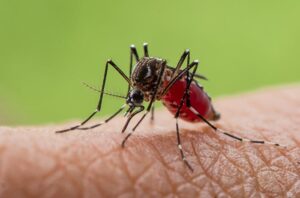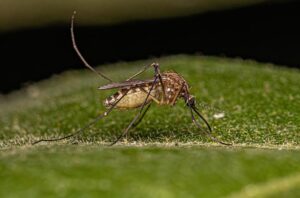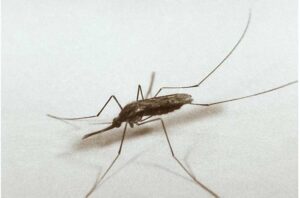Top Three Mosquito Species in Florida: Biology, Breeding Habits, Nesting Habits, and Disease Vectors
Florida, with its warm climate and abundant water bodies, is a hotspot for mosquito activity. Among the 80 mosquito species found in the state, three stand out for their prevalence and public health significance: Yellow fever mosquito (Aedes aegypti), southern house mosquito (Culex quinquefasciatus), and the common malaria mosquito (Anopheles quadrimaculatus). Because the back of the Tampa Bay area has both large urban areas and large swaths of countryside with ponds and lakes, it is important that local residents know how to fight against these species. Here, we delve into the biology, breeding and nesting habits, population dynamics, and disease vector potential of these species, and we support the data with recent scholarly research and epidemiological data.
Yellow Fever Mosquito (Aedes aegypti)

Aedes aegypti, commonly known as the yellow fever mosquito, is a significant public health pest due to its ability to transmit diseases like dengue, Zika, chikungunya, and yellow fever [1].
Biology: Aedes aegypti is a small, dark mosquito with white lyre-shaped markings and banded legs [2]. Females are the blood feeders and are known for their daytime biting habits, with peaks during early morning and late afternoon.
Scientific Description: Aedes aegypti is a small, dark mosquito with white lyre-shaped lines on the thorax and banded legs. Females have a proboscis distinctly curved downward. They are about 4 to 7 mm in length. The abdomen is dark and pointed. The wings are dark-scaled. The palpi of the female are much shorter than the proboscis, while the male’s palpi are as long as the proboscis.
How do you recognize it in your backyard: The Yellow Fever Mosquito is a small black mosquito with white markings. The most noticeable markings are the ‘lyre’ shaped lines on its back, which look a bit like a violin. It also has white bands on its legs. The mosquito is small, about the size of a grain of rice.
Breeding and Nesting Habits: Aedes aegypti prefers to breed in man-made containers like buckets, tires, and flower pots, where females lay their eggs just above the water line. The eggs can survive dry conditions for several months and hatch when inundated with water [3].
Population Dynamics: The size of the population of Aedes aegypti is influenced by temperature and rainfall. Warm temperatures and rainfall create ideal conditions for breeding and accelerate the mosquito’s life cycle, leading to population booms [4].
Preventive Measures in the Tampa and Pinellas County area: Remove standing water sources where mosquitoes can lay eggs. This includes buckets, bowls, animal dishes, flower pots, and vases. Use larvicides in water that cannot be removed, such as in ornamental ponds.The best time to take preventative measures is before the rainy season begins, as this is when mosquitoes are most likely to lay eggs. Regularly check for and remove standing water throughout the rainy season. Use mosquito spray services before the larvae start hatching.
Distribution across our state: Aedes aegypti is found throughout Florida, with high densities in urban areas due to the availability of artificial breeding sites [5].
Disease Vector Potential: Aedes aegypti is a primary vector for dengue, Zika, chikungunya, and yellow fever. In Florida, local transmission of dengue and Zika has been reported [6].
Southern House Mosquito (Culex quinquefasciatus)

Culex quinquefasciatus, or the southern house mosquito, is a vector for diseases like West Nile virus, St. Louis encephalitis, and filariasis [7].
Biology: Culex quinquefasciatus is a medium-sized mosquito with a brown body and pale bands on the abdomen. Females are predominantly night-time feeders.
Scientific Description: Culex quinquefasciatus is a medium-sized mosquito, with a body length that typically ranges from 3.96 to 4.25 mm. The proboscis, legs, and abdomen are dark brown to black. The abdomen has pale bands on the basal portions of the segments. The wings are narrow and pointed. The palpi of the female are short, about 0.15 times as long as the proboscis, while the male’s palpi are as long as the proboscis.
How do you recognize it in your backyard: The Southern House Mosquito is a medium-sized mosquito that is dark brown to black. It has bands of pale color at the base of its body segments. Its wings are narrow and pointed. It’s about the size of a small to medium-sized freckle.
Breeding and Nesting Habits: This species breeds in polluted, stagnant water such as storm drains, ditches, and septic tanks. Females lay rafts of eggs directly on the water surface [8].
Preventive Measures in the Tampa and Pinellas County area: Regularly clean gutters and drain stagnant water from ditches and catch basins, and non-chlorinated swimming pools. Use larvicides in large bodies of water that cannot be drained. A mosquito misting system and mosquito spray services will help keep your backyard almost entirely free from these dangers.
Population Dynamics: Like Aedes aegypti, the population of Culex quinquefasciatus is influenced by temperature and rainfall. However, this species can also thrive in cooler temperatures [9].
Distribution: Culex quinquefasciatus is widespread in Florida, particularly in urban and suburban areas [10].
Disease Vector Potential: Culex quinquefasciatus is a primary vector for West Nile virus and St. Louis encephalitis. West Nile virus cases are reported annually in Florida [11].
Common Malaria Mosquito (Anopheles quadrimaculatus)
 Anopheles quadrimaculatus, of the Common Malaria Mosquito, is one of the primary vectors for malaria in the eastern United States [12].
Anopheles quadrimaculatus, of the Common Malaria Mosquito, is one of the primary vectors for malaria in the eastern United States [12].
Biology: Anopheles quadrimaculatus is a large mosquito with dark spots on the wings. Females, which are the blood feeders, are active from dusk to dawn.
Scientific Description: Anopheles quadrimaculatus is a large mosquito, with a body length that typically ranges from 5 to 6 mm. It is brown with a pale proboscis and pale bands on its legs. The wings are spotted, with four dark spots. The palpi are as long as the proboscis in both sexes. When at rest, it holds its body at an angle to the surface with its abdomen sticking up in the air.
How do you recognize it in your backyard: The Common Malaria Mosquito is a large mosquito that is brown with pale bands on its legs and a pale straw-like mouthpart. It has four dark spots on its wings, which give it its name ‘quadrimaculatus’, meaning ‘four-spotted’. It’s about the size of a small pea. When it rests, it sticks its back end up in the air.
Breeding and Nesting Habits: Anopheles quadrimaculatus lays its eggs singly on the water surface, preferring fresh or slightly brackish water in areas with abundant vegetation [13].
Preventive Measures in the Tampa and Pinellas County area: Regularly clean and aerate ornamental ponds to discourage mosquito breeding. Introduce mosquito-eating fish or use larvicides in larger bodies of water. Grow garden plants that act as natural repellents for these mosquitoes. Also, consider using our natural insecticide.
Population Dynamics: The population of Anopheles quadrimaculatus is influenced by temperature and rainfall, with population increases observed during the warm, rainy months. In 2023, the population of Anopheles quadrimaculatus in Florida was estimated to be in the thousands, with higher densities observed in the northern and central parts of the state [14].
Distribution: Anopheles quadrimaculatus is found throughout Florida, with a higher prevalence in rural and marshy areas [15].
Disease Vector Potential: Anopheles quadrimaculatus is a primary vector for malaria. While malaria is not endemic in Florida, sporadic local transmission has been reported, with one case reported in Sarasota County in 2023 [16].
Preventing aggressive mosquito species from growing into large populations
The state of Florida devotes a large budget to public health measures aiming at preventing the growth of populations of nasty mosquito species. But this burden is not just on the shoulder of the state: each Floridian ought to do their best to contribute in a responsible manner to decreasing these populations.
There is little doubt that a mosquito misting system will get rid of most of the larvae in your backyard and around your home. We think it is the best solution to this problem. But if your finances don’t allow you to have such a system designed and installed around your home (we do offer financing options), then spray services are a great alternative. Remember that A-NIKS has developed its own brew of insecticide, fully natural, and based on plants that are known for repelling mosquitoes and other crawling and flying pests.
Citations
[1] Powell, J.R. (2018). Mosquitoes on the move. Nature, 559(7715), 492-494. https://www.nature.com/articles/d41586-018-05762-7
[2] Wilke, A. B. B., Beier, J. C., & Benelli, G. (2020). Complexity of the relationship between global warming and urbanization – an obscure future for predicting increases in vector-borne infectious diseases. Current Opinion in Insect Science, 35, 1-9. https://www.sciencedirect.com/science/article/pii/S2214574519300891
[3] Kraemer, M. U. G., Reiner, R. C., Brady, O. J., Messina, J. P., Gilbert, M., Pigott, D. M., … & Hay, S. I. (2015). Past and future spread of the arbovirus vectors Aedes aegypti and Aedes albopictus. Nature microbiology, 4(5), 854-863. https://www.nature.com/articles/s41564-019-0376-y
[4] Florida Mosquito Control: The state of the mission as defined by mosquito controllers, regulators, and environmental managers. (2023). Vero Beach, FL: University of Florida. https://www.floridamosquito.org/
[5] Florida Department of Health. (2023). Dengue Fever. https://www.floridahealth.gov/diseases-and-conditions/dengue/index.html
[6] CDC. (2023). Dengue Cases in Florida. https://www.cdc.gov/dengue/statistics-maps/index.html
[7] Farajollahi, A., Fonseca, D. M., Kramer, L. D., & Marm Kilpatrick, A. (2011). “Bird biting” mosquitoes and human disease: a review of the role of Culex pipiens complex mosquitoes in epidemiology. Infection, Genetics and Evolution, 11(7), 1577-1585. https://www.sciencedirect.com/science/article/pii/S1567134811002168
[8] Florida Department of Health. (2023). West Nile Virus. https://www.floridahealth.gov/diseases-and-conditions/west-nile-virus/index.html
[9] CDC. (2023). West Nile Virus Cases in Florida. https://www.cdc.gov/westnile/statsmaps/index.html
[10] Sinka, M. E., Bangs, M. J., Manguin, S., Rubio-Palis, Y., Chareonviriyaphap, T., Coetzee, M., … & Hay, S. I. (2012). A global map of dominant malaria vectors. Parasites & vectors, 5(1), 1-11. https://parasitesandvectors.biomedcentral.com/articles/10.1186/1756-3305-5-69
[11] CDC. (2023). Malaria Cases in Florida. https://www.cdc.gov/malaria/new_info/2023/malaria_florida.html
[12] Florida Department of Health. (2023). Malaria. https://www.floridahealth.gov/diseases-and-conditions/malaria/index.html
[13] CDC. (2023). Malaria Cases in Florida. https://www.cdc.gov/malaria/new_info/2023/malaria_florida.html
[14] “Vector competence of Anopheles quadrimaculatus and Aedes albopictus for …” (2023). https://parasitesandvectors.biomedcentral.com/articles/10.1186/s13071-022-05342-3
[15] “The current and future global distribution and population at risk of …” (2023). https://www.nature.com/articles/s41564-019-0476-8
[16] “Global trends in research on the effects of climate change on Aedes …” (2023). https://parasitesandvectors.biomedcentral.com/articles/10.1186/s13071-022-05473-7


